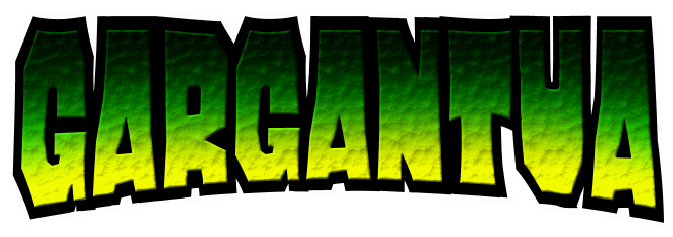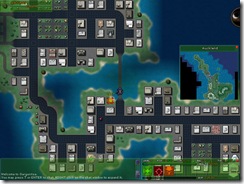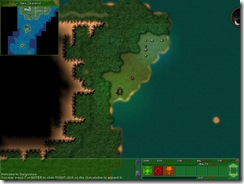
Nemesis Games announced the development of their new MMO, Gargantua, in August of 2009. The game is a 2D tile-based map game where players will control giant monsters rampaging across the Earth, destroying cities, eating nuclear power plants, and terrorizing countries. We interviewed Jeff Dee, President of Nemesis Games, about their upcoming release and are happy to present his passion to our readers.
The game begins on a fateful day when Earth is invaded by aliens: the Yrions.
“There is a narrative behind the game overall: the evil alien Yrions have created you (or awakened you from your ancient slumber), along with all of the other giant monsters, for the purpose of softening up Earth’s defenses in preparation for invasion,” Jeff Dee explains. “But once awakened, you’re not controllable: you’ll find Yrion outposts during your wanderings, and can destroy those too.”
Upon character creation players will be able to choose two major aspects of their creatures which will drive their game play throughout the rest of their monstrous careers: shape and energy-source. Shapes hail from every giant monster movie trope including ape, blob, colossus, giantess, insect, kraken, mech, plant, roc, and saurian. The shape of the monster guides what types of abilities it has. Next is energy source, which of course also run the movie-monster tropes with atomic, biochemical, electrical, mental, mystical, thermal, and mechanical. For example, taken from this list Godzilla would be an atomic saurian.
[ad#Helvetica Left-align]As the game will have both free and subscription pay grades, the subscription appears to be a value-added pay model. People playing with the free subscription will only have access to three shapes: ape, giantess, and saurian. In order to access the other shapes (like the ever-so-awesome blob) customers will have to become paying subscribers.
Player monsters should be customizable aside from having a particular shape. Upon creation players get to choose their initial color and a pattern (stripes, spots, etc.) and some sort of additional detail (wings, tentacles, a crest, etc.) although probably only things appropriate to their shape. Another very interesting customization that sets this game apart from the traditional MMO is that instead of just what monsters look like, players will be able to customize what they sound like.
Every monster gets a roar. In game, the roar causes the monster to rear back and scream—which causes it to hold still, but recover some hit points. The player gets to choose from a list of basic battle-scream sounds and then adjust them using pitch and tone sliders. In this fashion, different players will be able to recognize one another by hearing the signature cry of another monster nearby.
Unlike the traditional MMO, monsters don’t have a mission and contact based story structure, they’re more or less irritated and hungry. Rather like most old monster movies where the motivations of the giant monsters seemed pretty straightforward; but the humans just kept getting in their way and needed to be stomped. We asked Dee about this aspect of the game.
 “The Yrions don’t give you missions or anything; you’re driven by your Hungers. At all times, you have a short list of things you most desire to destroy – and you get bonuses for satisfying your Hungers. There are also Energy Buildings—human or Yrion facilities—that produce each of the different Energy Types. They’re basically power-ups, but you want to find the ones that match your monster’s own Energy Type. We have a story development that occurs in the elder game, for high-level monsters, but we’re not talking about that yet.”
“The Yrions don’t give you missions or anything; you’re driven by your Hungers. At all times, you have a short list of things you most desire to destroy – and you get bonuses for satisfying your Hungers. There are also Energy Buildings—human or Yrion facilities—that produce each of the different Energy Types. They’re basically power-ups, but you want to find the ones that match your monster’s own Energy Type. We have a story development that occurs in the elder game, for high-level monsters, but we’re not talking about that yet.”
He says that Nemesis Games found inspiration in the old classic Japanese monster movies. This inspiration motivates how the game pushes players to enter cities, eat populations, and fight other monsters—not the standard missions.
“So the ‘missions’ are pretty simplistic: Godzilla is driven by Atomic power, so he wades into cities looking for atomic waste dumps, nuclear power plants, and so on – destroying whatever gets in his way, including civilians, vehicles, the military, aliens, and other monsters. Or he may Hunger for a jet fighter (I don’t know why—who does?), and go looking for those to eat (with similar results). Godzilla is not motivated by deep elaborate narrative; he’s motivated by simple, powerful internal drives. Talking to ‘contacts’ to get ‘missions’ wouldn’t make any sense for him.”
 Likewise, there’s no system for buying or trading items—not like giant monsters have any need for that—instead when items or objects fall out of buildings or other monsters they can be consumed by the giant monsters for various effects. Two game mechanics exist for this purpose: Digest and Metabolize. When a giant monster Digests something it absorbs its power into itself for a temporary buff, like a power-up or a potion in another game; but when a monster Metablolizes a thing it adds it to its internal structure permanently, similar to equipping an item. “There’s no waste: you can use everything that drops, one way or the other,” Dee elaborates. “Because, again, you don’t see Godzilla going to a store (except to destroy it), or trading with other monsters (except for trading blows).”
Likewise, there’s no system for buying or trading items—not like giant monsters have any need for that—instead when items or objects fall out of buildings or other monsters they can be consumed by the giant monsters for various effects. Two game mechanics exist for this purpose: Digest and Metabolize. When a giant monster Digests something it absorbs its power into itself for a temporary buff, like a power-up or a potion in another game; but when a monster Metablolizes a thing it adds it to its internal structure permanently, similar to equipping an item. “There’s no waste: you can use everything that drops, one way or the other,” Dee elaborates. “Because, again, you don’t see Godzilla going to a store (except to destroy it), or trading with other monsters (except for trading blows).”
The entire game will be played across one big map covering the entirety of the Earth’s surface. However, the launch will probably be a little bit more modest, giving players access to a slice from India in the west to American Samoa in the east, and from Antarctica in the south to Indonesia in the north. The next major expansion plans to add Japan or perhaps the Artic as well. With the goal being the entire Earth.
The game runs using a gaming engine developed by Jason Ely for his upcoming game Elderlands. It’s written entirely atop that platform using the built-in scripting language called Ooz.
When asked what his MMO provides that others do not? Jeff Dee leaves us with exactly what we expect everyone will want to play the game for:
“Two words: GIANT MONSTERS.”

Recent Comments